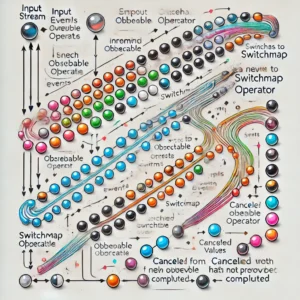As a software developer, I have always been fascinated by the concept of design patterns. Design patterns are tried-and-true solutions to common software design problems that have been developed over the years by experienced developers. They provide a standardized way of solving recurring design problems in object-oriented systems, improving code quality, maintainability, and versatility.
There are different types of design patterns in software development, including creational, structural, and behavioral patterns. Creational patterns are designed for class instantiation, while structural patterns are designed with regard to a class’s structure and composition. Behavioral patterns, on the other hand, are designed to manage communication between objects and classes. By exploring different design patterns, software developers can learn how to organize their code, promote reusability, and simplify the design process, ultimately creating more efficient and high-quality software.
In this article, I will explore different design patterns in software development and their applications in various software domains, including web and mobile apps, enterprise systems, and embedded software. I will discuss the benefits of using design patterns, popular patterns in software development, and their importance in creating best practices. Whether you are a beginner or an experienced developer, this article will provide valuable insights into the world of software design patterns.
Understanding Design Patterns
Design patterns are reusable solutions to common problems that developers face during software development. They provide a structured approach to solving design problems and promote code reusability, modularity, and flexibility.
There are three main types of design patterns: creational, structural, and behavioral. Creational patterns are used to create objects in software applications, while structural patterns are used to organize code and relationships between objects. Behavioral patterns are used to manage communication between objects and classes.
Some examples of creational patterns include the singleton pattern, the factory pattern, and the builder pattern. The singleton pattern ensures that only one instance of a class is created and provides global access to that object. The factory pattern creates objects without specifying the exact class to be instantiated. The builder pattern separates the construction of a complex object from its representation.
Structural patterns include the adapter pattern, the decorator pattern, and the facade pattern. The adapter pattern allows incompatible objects to work together by converting the interface of one object into another. The decorator pattern adds functionality to an object dynamically without changing its structure. The facade pattern provides a simplified interface to a complex system of classes.
Behavioral patterns include the observer pattern, the command pattern, and the iterator pattern. The observer pattern allows objects to be notified of changes to another object’s state. The command pattern encapsulates a request as an object, allowing it to be passed as a parameter and stored for later use. The iterator pattern provides a way to access the elements of an object sequentially without exposing its underlying representation.
Understanding design patterns is essential for developers to write high-quality, efficient, and maintainable code. By using established patterns, developers can avoid unnecessary repetition and focus on creating solutions to problems specific to their project.
Creational Design Patterns
In software development, Creational Design Patterns are used to create objects in a flexible and efficient way. These patterns provide solutions to common problems that developers encounter during the object creation process. In this section, I will discuss five types of Creational Design Patterns.
Singleton Pattern
The Singleton Pattern ensures that at most only one instance of an object exists throughout the application. This pattern is useful when you want to restrict the creation of a class to a single instance. The Singleton Pattern is implemented by creating a private constructor, a private static instance, and a public static method that returns the instance.
Factory Method Pattern
The Factory Method Pattern creates objects of several related classes without specifying the exact object to be created. This pattern is useful when you want to create objects that share a common interface. The Factory Method Pattern is implemented by creating an abstract class or interface for the factory and subclasses for each type of object.
Abstract Factory Pattern
The Abstract Factory Pattern creates families of related dependent objects. This pattern is useful when you want to create objects that have dependencies on other objects. The Abstract Factory Pattern is implemented by creating an abstract class or interface for the factory and subclasses for each type of object.
Builder Pattern
The Builder Pattern separates the construction of a complex object from its representation. This pattern is useful when you want to create objects that have multiple attributes or properties. The Builder Pattern is implemented by creating a builder class that has methods to set each attribute or property of the object and a build method that returns the final object.
Prototype Pattern
The Prototype Pattern creates new objects by cloning existing objects. This pattern is useful when you want to create objects that are similar to existing objects. The Prototype Pattern is implemented by creating a prototype interface or abstract class and concrete classes that implement the prototype.
In conclusion, Creational Design Patterns provide an efficient and flexible way to create objects in software development. The Singleton, Factory Method, Abstract Factory, Builder, and Prototype Patterns are just a few examples of the many Creational Design Patterns that can be used to solve common object creation problems.
Structural Design Patterns
Structural design patterns focus on the composition of classes and objects to form larger structures. These patterns help to simplify the relationships between objects and make it easier to modify them. There are several structural design patterns, and each has its unique use case. In this section, I will discuss some of the most commonly used structural design patterns.
Adapter Pattern
The Adapter pattern allows two incompatible interfaces to work together. It acts as a bridge between two incompatible interfaces and enables communication between them. The Adapter pattern can be useful when you need to integrate a new system with an existing one.
Bridge Pattern
The Bridge pattern separates the abstraction from its implementation. It allows you to change the implementation without affecting the abstraction. This pattern can be useful when you need to decouple an abstraction from its implementation.
Composite Pattern
The Composite pattern allows you to treat a group of objects as a single object. It creates a tree-like structure of objects, where each object can have other objects as children. This pattern can be useful when you need to represent a hierarchy of objects.
Decorator Pattern
The Decorator pattern allows you to add functionality to an object dynamically. It wraps an object and adds new behavior without changing the original object’s structure. This pattern can be useful when you need to add new functionality to an object without modifying its existing behavior.
Facade Pattern
The Facade pattern provides a simplified interface to a complex system. It hides the complexity of the system and provides a simple interface for the client to interact with. This pattern can be useful when you need to simplify a complex system and provide a user-friendly interface.
Flyweight Pattern
The Flyweight pattern reduces the memory footprint of an application by sharing common objects. It creates a pool of objects and reuses them instead of creating new objects. This pattern can be useful when you need to create a large number of objects with similar properties.
Proxy Pattern
The Proxy pattern provides a surrogate object that acts as a placeholder for another object. It controls access to the original object and allows you to add additional functionality. This pattern can be useful when you need to control access to an object or add additional functionality to it.
In conclusion, structural design patterns help to simplify the relationships between objects and make it easier to modify them. The Adapter, Bridge, Composite, Decorator, Facade, Flyweight, and Proxy patterns are some of the most commonly used structural design patterns. Each pattern has its unique use case, and you should choose the pattern that best suits your requirements.
Behavioral Design Patterns
In software development, Behavioral Design Patterns are a set of guidelines that help identify common communication patterns among objects. These patterns provide a way to solve commonly occurring object-interaction-related problems in software design.
Chain of Responsibility Pattern
The Chain of Responsibility pattern allows a request to pass through a chain of handlers. Each handler decides whether to process the request or pass it to the next handler in the chain. This pattern provides flexibility in handling requests and avoids coupling the sender of the request to its receiver.
Command Pattern
The Command pattern encapsulates a request as an object, allowing you to parameterize clients with different requests, queue or log requests, and support undoable operations. This pattern separates the requester of an action from the object that performs the action.
Interpreter Pattern
The Interpreter pattern defines a grammatical representation for a language and provides an interpreter to interpret sentences in the language. This pattern is useful for building parsers and compilers.
Iterator Pattern
The Iterator pattern provides a way to access the elements of an aggregate object sequentially without exposing its underlying representation. This pattern decouples the algorithm from the underlying data structure and provides a uniform interface for traversing different aggregate structures.
Mediator Pattern
The Mediator pattern defines an object that encapsulates the communication between a set of objects. This pattern promotes loose coupling between objects and reduces the complexity of communication between them.
Memento Pattern
The Memento pattern provides a way to capture and restore an object’s internal state without violating encapsulation. This pattern is useful for implementing undo and redo operations.
Observer Pattern
The Observer pattern defines a one-to-many dependency between objects, so that when one object changes state, all its dependents are notified and updated automatically. This pattern promotes loose coupling between objects and allows for easy addition and removal of observers.
State Pattern
The State pattern allows an object to alter its behavior when its internal state changes. This pattern promotes loose coupling between objects and simplifies the code by eliminating large conditional statements.
Strategy Pattern
The Strategy pattern defines a family of algorithms, encapsulates each one, and makes them interchangeable. This pattern allows for easy addition and removal of algorithms and promotes loose coupling between objects.
Template Method Pattern
The Template Method pattern defines the skeleton of an algorithm in a method, deferring some steps to subclasses. This pattern allows subclasses to redefine certain steps of an algorithm without changing its structure.
Visitor Pattern
The Visitor pattern allows you to add new operations to existing object structures without modifying those structures. This pattern separates the algorithm from the object structure and promotes loose coupling between objects.
In conclusion, Behavioral Design Patterns provide a way to solve commonly occurring object-interaction-related problems in software design. By using these patterns, developers can create flexible, reusable, and maintainable software systems.
Anti-Patterns and Best Practices
As a software developer, it is important to not only understand design patterns but also recognize and avoid anti-patterns. Anti-patterns are common pitfalls or mistakes that occur in software development. They may seem like good solutions at first glance, but ultimately lead to poor design, inefficient code, and difficult maintenance. In this section, I will discuss how to recognize and avoid anti-patterns and common pitfalls in design patterns.
Recognizing and Avoiding Anti-Patterns
Recognizing and avoiding anti-patterns is crucial for creating maintainable and efficient code. Here are some best practices to help avoid anti-patterns:
- Follow coding conventions and best practices
- Write clean and readable code
- Refactor code regularly
- Use design patterns appropriately
- Avoid over-engineering and premature optimization
- Test code thoroughly
- Document code clearly
By following these best practices, you can avoid common anti-patterns and create maintainable and efficient code.
Common Pitfalls in Design Patterns
While design patterns can be powerful tools for creating maintainable and efficient code, there are also common pitfalls to watch out for. Here are some common pitfalls in design patterns:
- Overuse of design patterns: Overusing design patterns can lead to code that is difficult to read and maintain.
- Ignoring context: Design patterns should be used in the appropriate context. Ignoring context can lead to code that is inefficient and difficult to maintain.
- Not understanding the pattern: Using a design pattern without fully understanding it can lead to code that is difficult to maintain and inefficient.
- Not adapting to changing requirements: Design patterns should be adapted to changing requirements. Not adapting to changing requirements can lead to code that is difficult to maintain and inefficient.
By being aware of these common pitfalls, you can use design patterns effectively and create maintainable and efficient code.
In conclusion, recognizing and avoiding anti-patterns and common pitfalls in design patterns is crucial for creating maintainable and efficient code. By following best practices and being aware of common pitfalls, you can use design patterns effectively and create code that is easy to read, maintain, and test.
Best Practices in Design Pattern Usage
As a software developer, I have come to realize that using design patterns is an effective way to solve common software development problems. However, it is important to use them correctly to maximize their benefits. In this section, I will discuss some best practices that can help in effective design pattern implementation.
Guidelines for Effective Design Pattern Implementation
1. Understand the Problem
Before implementing a design pattern, it is important to understand the problem that needs to be solved. This helps in selecting the appropriate design pattern that will effectively solve the problem.
2. Keep it Simple
Design patterns are meant to simplify software development, not complicate it. It is important to keep the design pattern implementation simple and easy to understand. Avoid over-engineering or overusing design patterns as it can lead to unnecessary complexity.
3. Follow Standard Practices
Design patterns have been established as standard practices in software development. It is important to follow these practices to ensure that the design pattern implementation is effective and efficient.
4. Document the Design Pattern Implementation
Documenting the design pattern implementation is important for future reference. It helps in understanding the design pattern implementation and its purpose. It also helps in maintaining the code and making future modifications.
5. Test the Design Pattern Implementation
Testing the design pattern implementation is important to ensure that it works as expected. It also helps in identifying any issues or bugs in the implementation. Testing should be done at different stages of the development process to ensure that the design pattern implementation is effective.
In conclusion, using design patterns is an effective way to solve common software development problems. However, it is important to use them correctly to maximize their benefits. By following the guidelines outlined in this section, you can effectively implement design patterns in your software development projects.
Conclusion
In conclusion, design patterns are a crucial aspect of software development that provide developers with reusable solutions to common problems encountered during the design process. By adhering to established patterns, developers can avoid unnecessary repetition and focus more on creating efficient, high-quality code.
Throughout this article, we explored various design patterns, including Singleton, Observer, Factory, and more, explaining their purpose and how they can be implemented in software development. We also discussed how design patterns promote code reusability, modularity, and flexibility, allowing developers to create dynamic solutions that can be adapted to changing requirements.
It is important to note that while design patterns offer standardized solutions, they should not be used blindly. Developers must carefully consider the requirements of their project and choose the appropriate pattern that fits their needs. Additionally, design patterns should not be seen as a replacement for good software design practices, but rather as a tool to enhance them.
Overall, design patterns are a valuable resource for developers looking to improve their software development skills and create efficient, maintainable code. By incorporating these patterns into their workflow, developers can streamline their design process and produce high-quality software that meets the needs of their users.
Further Reading and Resources
Delving deeper into the realm of design patterns can be a rewarding journey for developers looking to refine their skills and enhance their understanding of software architecture. Read my other articles about coding best practices “Best Practices for Clean Code and Code Refactoring: Tips from Industry Experts.” Additionally, here are some recommended books, websites, and online resources to further your exploration of design patterns:
Books:
- “Design Patterns: Elements of Reusable Object-Oriented Software” by Erich Gamma, Richard Helm, Ralph Johnson, and John Vlissides
- A seminal work often referred to as the “Gang of Four” (GoF) book, offering in-depth insights into 23 classic design patterns.
- “Head First Design Patterns” by Eric Freeman, Elisabeth Robson, Bert Bates, Kathy Sierra
- A beginner-friendly and interactive approach to learning design patterns, with a focus on practical implementation.
- “Clean Code: A Handbook of Agile Software Craftsmanship” by Robert C. Martin
- While not solely focused on design patterns, this book emphasizes clean coding practices and is an essential read for any developer.
Websites and Online Resources:
- Refactoring Guru – Design Patterns
- https://refactoring.guru/design-patterns
- An online resource providing detailed explanations, real-world examples, and interactive diagrams for various design patterns.
- DZone – Design Patterns
- https://dzone.com/refcardz/design-patterns
- DZone’s Refcardz on design patterns is a concise reference guide with quick overviews and code examples.
- SourceMaking – Design Patterns
- https://sourcemaking.com/design_patterns
- SourceMaking offers articles and examples explaining design patterns, with a focus on practical application.
- GitHub – Design Patterns in Java
- https://github.com/iluwatar/java-design-patterns
- A GitHub repository with Java implementations of numerous design patterns, contributed by the community.
Interactive Platforms:
- HackerRank – Design Patterns
- https://www.hackerrank.com/domains/tutorials/10-days-of-javascript
- HackerRank provides challenges and tutorials on implementing design patterns in various programming languages.
- LeetCode – Design Patterns
- https://leetcode.com/problemset/all/?search=design%20pattern
- LeetCode features coding problems that can be solved using design patterns, offering a practical approach to learning.
Community Forums:
- Stack Overflow – Design Patterns Questions
- https://stackoverflow.com/questions/tagged/design-patterns
- Stack Overflow’s design-patterns tag is a valuable resource for finding answers to specific design pattern-related questions.
- Reddit – r/learnprogramming
- https://www.reddit.com/r/learnprogramming/
- The learnprogramming subreddit is a community where developers often discuss and seek advice on design patterns.
These resources cover a wide spectrum of learning styles, from books and tutorials to interactive platforms and community forums. Whether you’re a novice seeking an introduction or an experienced developer looking to deepen your understanding, these recommendations offer valuable insights into the world of design patterns. Happy coding!






